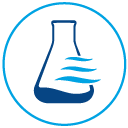
How Stormwater Runoff is Polluting our Waterways
An Overview of Stormwater Runoff
The original stormwater systems were designed to create pathways for rainwater to quickly be removed from streets during heavy storms. However, because these systems were not designed to provide treatment of the runoff waters, they easily carry all kinds of pollutants from our streets, fields, industrial areas and parking lots, directly into local waterways and sources.
Stormwater runoff pollution sweeps up anything in the path of its flow or that finds its way into the sewer system. This includes chemicals, all kinds of trash, sewage overflow, cooking oil, bacteria from animal waste, oil, gas, fertilizers, paint and construction debris. Anything that gets dumped, thrown on the ground or runs through gutters will likely end up in the nearest stream, river, lake and eventually our ocean beaches.
Stormwater runoff pollution is significant because, unlike the water from your home’s sink or toilet, stormwater flows directly into a lake, river, or the ocean without any treatment.
Types of Stormwater Pollutants
Because water runoff flows from agricultural fields, livestock pens, buildings, streets, highways, industrial facilities, parking lots and construction sites, it can carry a wide range of pollutants. Oil, gasoline, antifreeze, detergents, fertilizers, pesticides, herbicides, industrial chemicals, industrial waste, bacteria from animal feces, litter, food scraps and much more gets swept up in the flowing waters and goes untreated through the stormwater drainage system. This system feeds directly into the nearest streams, rivers, lakes, reservoirs and on into the ocean. Any of these pollutants will degrade water quality and adversely affect local freshwater and marine life.
State Water Resources Control Boards, Regional Water Quality Control Boards and the US Environmental Protection Agency (EPA) have all made stormwater runoff pollution regulation a priority concern. Fines for violations from major sources of water pollution, like parking lot stormwater drains, industrial plants, chemical factories, agricultural fields, livestock facilities, construction sites and many other high risk areas, are growing in frequency and in cost.
Industrial Contributions to Stormwater Runoff Pollution
The Federal Government has identified eleven different categories of industrial activities that must be regulated to meet stormwater quality standards. These are the industrial stormwater categories:
- Category One (i): Facilities subject to federal stormwater effluent discharge standards at 40 CFR Parts 405-471.
- Category Two (ii): Heavy manufacturing (e.g., paper mills, chemical plants, petroleum refineries, steel mills and foundries).
- Category Three (iii): Coal and mineral mining, and oil and gas exploration and processing.
- Category Four (iv): Hazardous waste treatment, storage, and disposal facilities.
- Category Five (v): Landfills, land application sites, and open dumps with industrial wastes.
- Category Six (vi): Metal scrap yards, salvage yards, automobile junkyards and battery reclaimers.
- Category Seven (vii): Steam electric power generating plants.
- Category Eight (viii): Transportation facilities that have vehicle maintenance, equipment cleaning or airport deicing operations.
- Category Nine (ix): Treatment works treating domestic sewage with a design flow of 1 million gallons a day or more.
- Category Ten (x): Construction sites that disturb 5 acres or more (permitted separately).
- Category Eleven (xi): Light manufacturing (e.g., food processing, printing and publishing, electronic and other electrical equipment manufacturing, public warehousing and storage).
https://www.epa.gov/npdes/stormwater-discharges-industrial-activities
The US EPA authorizes most states to administer the NPDES stormwater permitting program. Most industrial facilities must obtain NPDES permit coverage through their state. The EPA itself is the permitting authority in some states, most territories and on Native American Indian territory. Any industrial facilities that are located in areas under EPA jurisdiction must apply for permit coverage under EPA’s 2021 Multi-Sector General Permit (MSGP).
How Stormwater Testing Helps Control Pollution
The main way that the states and the federal government control industrial stormwater quality is through regular required stormwater testing and site inspections.
According to the Industrial General Permit (IGP) issued by the California Regional Water Quality Control Board, permit holders are required to collect and analyze stormwater samples from each discharge location for two Qualified Stormwater Events (QSEs) within the first half of each reporting year (July 1 to December 31), and two QSEs within the second half of each reporting year (January 1st to June 30th). As detailed in each IGP holder’s Storm Water Pollution Prevention Plan (SWPPP), the tests required for all facilities include:
- Total Suspended Solids (TSS)
- pH (in the field)
- Oil & Grease
Additional tests are determined by the category of the industry (SIC) and the contaminants most likely to be found in runoff from the location. All Dischargers are required to submit and certify all reports electronically via the Storm Water Multiple Application and Report Tracking System (SMARTS).
Conclusion
The EPA controls stormwater pollution at industrial and construction sites by inspecting them and enforcing the agency’s requirements. Torrent Laboratory works closely with regulatory agencies to ensure our clients are meeting all of the legal obligations to meet industrial stormwater quality standards and requirements. Torrent will provide you with complete analytical services so that you will remain in compliance with all the requirements of NPDES programs administered by California’s State Water Resources Quality Control Board for industrial stormwater, municipalities, construction activities and Caltrans. Or, if you are located in another state or territory, Torrent will help you meet your state’s regulations.
Torrent Laboratory is your partner for stormwater testing, stormwater runoff analysis, remediation and stormwater monitoring plans. We are proud to work in partnership with regulatory boards, industries, developers and communities to meet and exceed all regulatory requirements in order to benefit and enhance the health and future of all of us. We have the most advanced testing capabilities available, the most experienced engineers, the fastest TAT’s and the best customer service in the industry.






